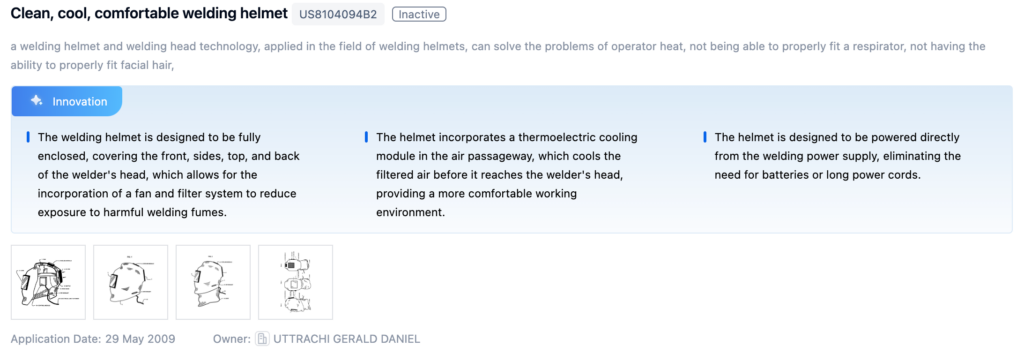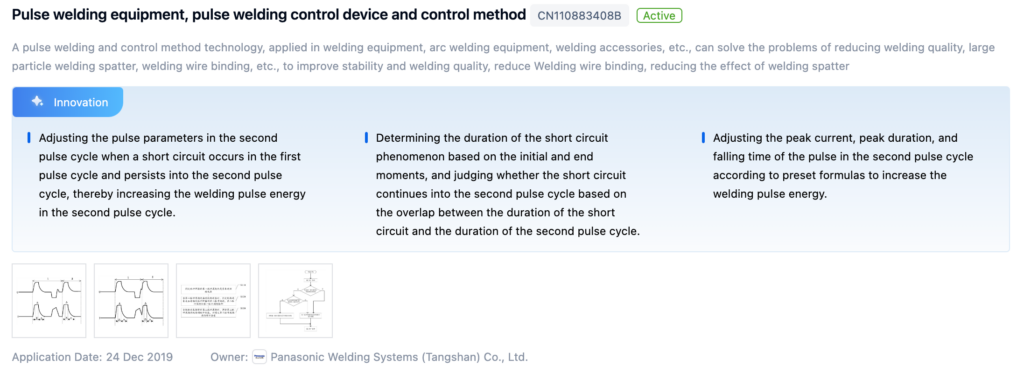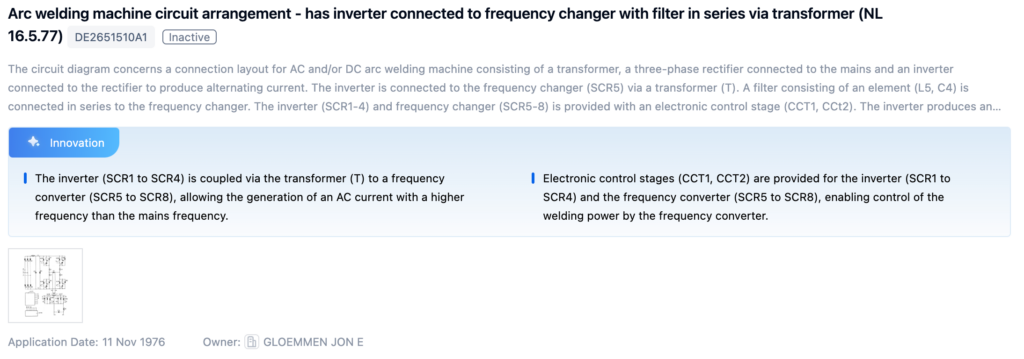
Technical Background and Objectives
Background
In the field of stick welding, improving welding quality has been a consistent focus of research and development efforts. The patent application data shows a steady increase in the number of filings over the years, indicating growing interest and investment in this area. However, literature publications related to improving welding quality in stick welding are relatively low and sporadic. This discrepancy suggests that research efforts may be driven by industrial or commercial entities focused on developing proprietary technologies and securing intellectual property rather than academic research.

Objectives
The primary objective is to enhance the quality of stick welding by developing innovative solutions that address challenges and limitations. The aim is to improve overall welding quality, leading to increased efficiency, reliability, and cost-effectiveness.
To get a detailed scientific explanations of improving Welding Quality, try Eureka.
Technical Current Status Analysis
Stick Welding Overview
Stick welding, also known as shielded metal arc welding (SMAW), is widely used in various industries, including construction, shipbuilding, and manufacturing. It offers versatility, portability, and the ability to weld in various positions and environments. However, improving welding quality remains a significant challenge.
Applications and Impact:
- Construction: Structural steel fabrication, rebar connections, and on-site welding tasks.
- Shipbuilding: Fabrication and repair of ships and offshore structures.
- Manufacturing: Fabrication of machinery, equipment, and pressure vessels.
Technical Characteristics and Challenges:
- Operator Skill and Technique: Manual process heavily reliant on operator skill, leading to inconsistencies.
- Electrode Quality and Selection: Proper selection and quality of electrodes influence weld properties.
- Welding Parameters: Appropriate settings for current, voltage, travel speed, and electrode angle are crucial.
- Environmental Conditions: Outdoor environments affect arc stability and overall weld quality.
- Joint Preparation and Fit-Up: Adequate joint preparation and alignment are critical for fusion and penetration.
- Post-Weld Treatment: Stress relief, heat treatment, and non-destructive testing (NDT) ensure weld quality.
Technological Paths:
- Advanced Welding Training and Certification Programs: Enhance operator skills using virtual and augmented reality technologies.
- Electrode Development and Optimization: Improve electrode quality and design for better weld properties.
- Automated Welding Parameter Control: Develop systems for real-time monitoring and adjustment.
- Welding Environment Control and Monitoring: Implement shielding and real-time environmental monitoring.
- Advanced Joint Preparation and Fit-Up Techniques: Use precision machining and automated systems for consistent preparation.
- Non-Destructive Testing (NDT) and Quality Control: Integrate advanced NDT techniques and automated quality control systems.
- Hybrid Welding Processes: Combine stick welding with other processes for enhanced quality.

Research Content
Research Objectives
Enhance the quality of stick welding by addressing challenges and limitations to improve overall welding quality, leading to increased efficiency, reliability, and cost-effectiveness.
Research Direction and Focus
Optimization of Welding Parameters
- Develop advanced algorithms and methodologies to determine optimal settings for current, voltage, travel speed, and electrode angle.
- Leverage computational modeling and experimental data to understand the relationships between parameters and weld quality.
Electrode Composition and Design
- Explore novel electrode materials and designs to enhance arc stability, reduce spatter, and improve weld penetration.
- Investigate techniques to extend electrode lifespan and reduce replacements.
Automation and Process Monitoring
- Integrate advanced automation and process monitoring systems using machine vision, AI, and real-time data analysis.
- Develop intelligent systems for real-time monitoring and adjustment of the welding process.
Operator Training and Skill Enhancement
- Explore innovative training methods using virtual reality simulations, interactive tutorials, and comprehensive programs.
Technical Development Roadmap
Key Areas of Advancement
- Electrode and Consumable Technologies: Develop low-hydrogen electrode coatings, optimized flux-cored wire formulations, and improved electrode coating adhesion.
- Process Automation and Control: Implement automated parameter adjustment, weld quality monitoring systems, and adaptive control algorithms.
- Welding Power Source Technologies: Advance inverter-based power sources, high-frequency welding power sources, and optimize power source energy efficiency.

Main Player Analysis
Key Players and Focus
- The University of Texas at Austin: Focus on compression force uniformity and its impact on welding processes.
- Ricoh Co. Ltd.: Extensive patent portfolio on practical applications and product development in stick welding.
- Washington State University: Research on compression force uniformity and its impact on welding processes.
- Canon Inc.: Substantial patent portfolio on equipment design, process optimization, and quality control.
- Daiichi Shokai Co. Ltd.: Largest patent portfolio focusing on welding equipment and consumables.
Current Technical Solution Overview
Welding Parameter Optimization
- Machine Learning and Data Analytics: Optimize parameters by analyzing past welding data.
- Real-Time Monitoring and Feedback Control: Use sensors and imaging techniques for dynamic adjustments.
- Weld Quality Assessment and Verification: Employ visual inspection, NDT methods, and mechanical testing.
- Welding Process Modifications: Implement hybrid welding techniques, pulsed welding, and specialized methods.
- Weld Quality Prediction and Control Models: Develop mathematical models for predicting and controlling weld quality.
Weld Quality Assessment and Monitoring
- Sensor Data Monitoring: Use optical, acoustic, or thermal sensors for real-time quality assessment.
- Radiographic and Ultrasonic Inspection: Non-destructive methods for internal structure inspection.
- Machine Learning for Quality Prediction: Analyze sensor data and process parameters to predict weld quality.
- Resistance Spot Weld Quality Assessment: Techniques for assessing resistance spot welds.
Electrode and Consumable Improvements
- Consumable Electrode Composition and Design: Improve weld properties through specific alloy compositions and coatings.
- Consumable Electrode Feeding and Control: Enhance welding quality through precise control over electrode feed and positioning.
- Arc Initiation and Stabilization: Use methods like controlled arc striking and pulsed arc welding.
- Shielding Gas and Welding Environment: Select appropriate gases and control the welding environment.
Weld Joint Design and Preparation
- Weld Joint Design for Improved Performance: Optimize joint geometry and reduce stress concentrations.
- Real-Time Weld Quality Monitoring: Use imaging and sensor data to monitor weld quality.
- Application-Specific Joint Design: Tailor designs for specific applications or materials.
- Weld Quality Prediction and Control: Model and analyze weld parameters to estimate quality.
- Mechanical Testing for Weld Quality Assessment: Use flexural and contact-based methods for quality evaluation.
Welding Process Selection and Adaptation
- Hybrid Welding Techniques: Combine stick welding with other processes for better quality.
- Weld Quality Monitoring and Evaluation Systems: Use sensors and data analysis for real-time quality assessment.
- Mechanical Properties-Based Quality Determination: Analyze strength, hardness, and other properties.
- Real-Time Weld Quality Control: Monitor and adjust parameters during welding.
- Data Analytics and Machine Learning: Use advanced techniques for weld quality assessment.
Key Patent Interpretation
Patent Highlights
Patent 1: Clean Cool Comfortable Welding Helmet
- Core Invention Points:
- Enclosed design with fan and filter system to reduce exposure to harmful fumes.
- Thermoelectric cooling module for a comfortable working environment.
- Powered directly from the welding power supply.

Patent 2: Pulse Welding Equipment Control Method
- Core Invention Points:
- Adjusting pulse parameters to increase welding pulse energy.
- Determining short circuit duration and adjusting parameters accordingly.
- Adjusting peak current, duration, and falling time of the pulse.

Patent 3: Arc Welding Machine Circuit Arrangement
- Core Invention Points:
- Inverter connected to frequency converter via transformer for AC current generation.
- Electronic control stages for inverter and frequency converter.
- Higher frequency current for better control.

Possible Research Directions
- Welding Parameter Optimization: Optimize parameters for better penetration, fusion, and bead appearance.
- Electrode Selection and Conditioning: Improve electrode coating, flux formulation, and conditioning.
- Weld Quality Monitoring and Feedback Systems: Implement real-time monitoring and feedback systems.
- Joint Design and Preparation: Ensure proper geometry, fit-up, and surface cleanliness.
- Hybrid and Advanced Welding Techniques: Combine stick welding with other techniques for better control and quality.
If you want an in-depth research or a technical report, you can always get what you want in Eureka Technical Research. Try now!

